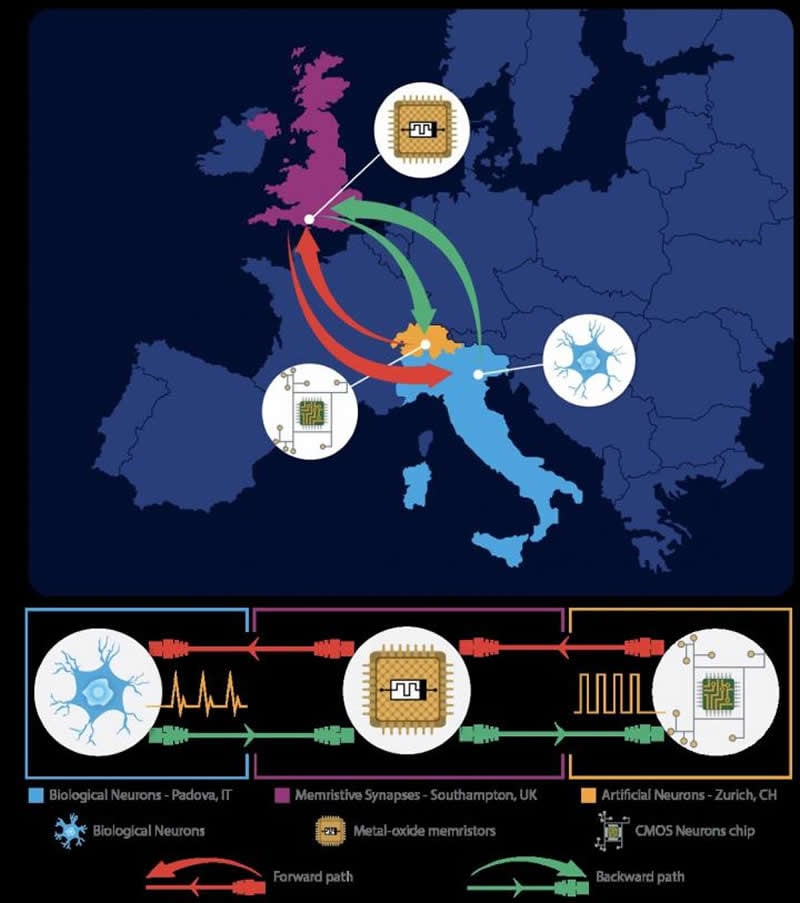Summary: Researchers have created a hybrid neural network where biological and artificial neurons in different parts of the world were able to communicate via the internet through a hub of memristive synapses.
Source: University of Southampton
Brain functions are made possible by circuits of spiking neurons, connected together by microscopic, but highly complex links called ‘synapses’. In this new study, published in the scientific journal Nature Scientific Reports, the scientists created a hybrid neural network where biological and artificial neurons in different parts of the world were able to communicate with each other over the internet through a hub of artificial synapses made using cutting-edge nanotechnology. This is the first time the three components have come together in a unified network.
During the study, researchers based at the University of Padova in Italy cultivated rat neurons in their laboratory, whilst partners from the University of Zurich and ETH Zurich created artificial neurons on Silicon microchips. The virtual laboratory was brought together via an elaborate setup controlling nanoelectronic synapses developed at the University of Southampton. These synaptic devices are known as memristors.
The Southampton based researchers captured spiking events being sent over the internet from the biological neurons in Italy and then distributed them to the memristive synapses. Responses were then sent onward to the artificial neurons in Zurich also in the form of spiking activity. The process simultaneously works in reverse too; from Zurich to Padova. Thus, artificial and biological neurons were able to communicate bidirectionally and in real time.

Themis Prodromakis, Professor of Nanotechnology and Director of the Centre for Electronics Frontiers at the University of Southampton said “One of the biggest challenges in conducting research of this kind and at this level has been integrating such distinct cutting edge technologies and specialist expertise that are not typically found under one roof. By creating a virtual lab we have been able to achieve this.”
The researchers now anticipate that their approach will ignite interest from a range of scientific disciplines and accelerate the pace of innovation and scientific advancement in the field of neural interfaces research. In particular, the ability to seamlessly connect disparate technologies across the globe is a step towards the democratisation of these technologies, removing a significant barrier to collaboration.
Professor Prodromakis added “We are very excited with this new development. On one side it sets the basis for a novel scenario that was never encountered during natural evolution, where biological and artificial neurons are linked together and communicate across global networks; laying the foundations for the Internet of Neuro-electronics. On the other hand, it brings new prospects to neuroprosthetic technologies, paving the way towards research into replacing dysfunctional parts of the brain with AI chips.”
Funding: The research was funded by the EU Future and Emerging Technologies programme as well as the Engineering and Physical Sciences Research Council in the UK. Professor Prodromakis also holds a Royal Academy of Engineering Chair in Emerging Technologies with a focus on developing energy-efficient AI Hardware solutions.
Source:
University of Southampton
Media Contacts:
Steve Bates – University of Southampton
Image Source:
The image is credited to University of Southampton.
Original Research: Open access
“Memristive synapses connect brain and silicon spiking neurons”. Alexantrou Serb, Andrea Corna, Richard George, Ali Khiat, Federico Rocchi, Marco Reato, Marta Maschietto, Christian Mayr, Giacomo Indiveri, Stefano Vassanelli & Themistoklis Prodromakis.
Scientific Reports doi:10.1038/s41598-020-58831-9.
Abstract
Memristive synapses connect brain and silicon spiking neurons
Brain function relies on circuits of spiking neurons with synapses playing the key role of merging transmission with memory storage and processing. Electronics has made important advances to emulate neurons and synapses and brain-computer interfacing concepts that interlink brain and brain-inspired devices are beginning to materialise. We report on memristive links between brain and silicon spiking neurons that emulate transmission and plasticity properties of real synapses. A memristor paired with a metal-thin film titanium oxide microelectrode connects a silicon neuron to a neuron of the rat hippocampus. Memristive plasticity accounts for modulation of connection strength, while transmission is mediated by weighted stimuli through the thin film oxide leading to responses that resemble excitatory postsynaptic potentials. The reverse brain-to-silicon link is established through a microelectrode-memristor pair. On these bases, we demonstrate a three-neuron brain-silicon network where memristive synapses undergo long-term potentiation or depression driven by neuronal firing rates.






